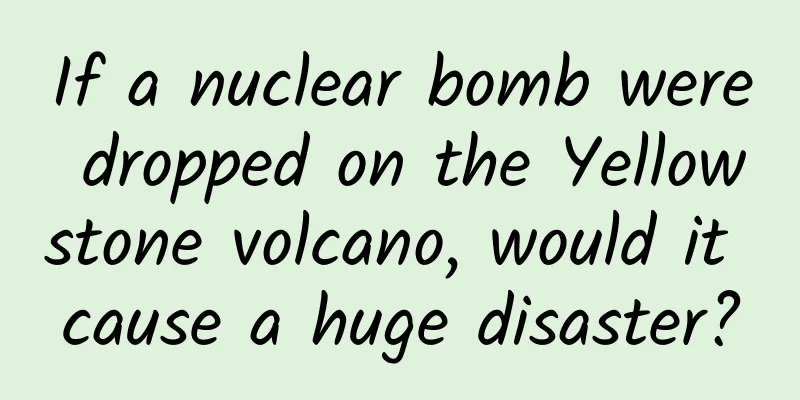If a nuclear bomb were dropped on the Yellowstone volcano, would it cause a huge disaster?

|
Yellowstone is a supervolcano located in Yellowstone National Park, Wyoming, USA. It is the largest and still active supervolcano in the world. Because the volcanoes in the area are still active, the geothermal resources in the area are also very rich. Two-thirds of the world's geysers are concentrated in Yellowstone Park, and Yellowstone Park has the most active geysers in the world. Unlike ordinary volcanoes, the Yellowstone supervolcano does not have a distinct mountain body like ordinary volcanoes, that is, it does not have a volcanic cone, and the whole is a flat plateau. It should have a volcanic cone like an ordinary volcano, but the reason why it is so unique is that the eruption was so powerful that the mountain body was flattened by the huge impact of the eruption, leaving only a crater-like depression on the surface, which is called a caldera or caldera (as shown in the figure below). Large volcanic eruptions often cause major natural disasters. As the world's largest active volcano, Yellowstone Volcano has naturally attracted much attention. According to geologists, Yellowstone Volcano has experienced three major eruptions in the past 2 million years, with the most recent large-scale eruption occurring 640,000 years ago. According to eruption records, it erupts about every 600,000 years. Logically, Yellowstone Volcano may erupt again in the next few tens of thousands of years, and scientists are very worried about this. Scientists have discovered that the underground geological activities of Yellowstone volcano are very active. According to the research of scientists from the University of Utah and the United States Geological Survey, the crust under the Yellowstone crater rose by 17 centimeters between 2004 and 2007, and the force that caused the crust to rise upward came from the accumulation of underground magma. The crust under Yellowstone Park is thinner than that in the surrounding areas, only more than 10 kilometers thick, and under the crust is lava, which is the source of the magma during the volcanic eruption. Currently, scientists are closely monitoring the volcanic activity of the Yellowstone supervolcano group, and no signs of eruption have been found. As for whether there will be another large-scale eruption in the future, scientists are not too sure. If a nuclear bomb is dropped on the Yellowstone volcano by humans, will it cause the volcano to erupt prematurely? How big a disaster will it cause? There are many types of nuclear bombs, with different explosive yields. The extent of the damage that a nuclear bomb dropped on Yellowstone volcano would cause depends mainly on the size of the nuclear bomb's yield. If it is a nuclear bomb of the level of the Hiroshima atomic bomb, it is basically equivalent to tickling. And a nuclear bomb of tens of millions of tons will only cause a small-scale low-intensity earthquake. If it is a 50 million-ton Tsar hydrogen bomb like the Soviet Union, burying this big guy under the Yellowstone volcano and detonating it, it is indeed possible to cause cracks or breaks in the crust under the Yellowstone volcano, which will trigger the eruption of the Yellowstone volcano, but the probability is not very high. Because many people may have overestimated the power of nuclear bombs. The energy released by a magnitude 7 or 8 earthquake is far greater than that of the Tsar hydrogen bomb. Only such a large force can cause cracks in the earth's crust in a short period of time. Therefore, in order to trigger the eruption of Yellowstone volcano, many Tsar hydrogen bombs should be needed. As for how many are needed, it also depends on the location of the nuclear bombs underground. If the eruption is not triggered, the harm caused by a Tsar hydrogen bomb exploding underground would not be too great. The nuclear radiation and high temperature would hardly cause harm to people on the ground, and it would only cause a medium-sized earthquake in the area. Even if an eruption is triggered, it is hard to say how strong it will be, because it is also related to the accumulation of magma underground in the Yellowstone volcano, which scientists are not quite sure about. If the Yellowstone volcano erupts on a small scale, the damage will not be too great. If it erupts on a large scale, not only the entire North American continent will be directly affected, but other parts of the world will also be affected. A large amount of volcanic ash entering the atmosphere can block the sun and change the earth's climate. Crops in many places may be reduced or even completely lost, eventually causing a huge disaster. For more exciting content, please follow the WeChat public account: Science Exploration Bacteria. |
<<: Why is allergic rhinitis more common in autumn? Can it be cured?
>>: Unfettered space exploration may be threatening the future of “space security”
Recommend
Make up for the shortcomings! An inventory of new features in the latest Android version of WeChat
Some time ago, the iOS system has started pushing...
[Creative Cultivation Program] Can edible straws be eaten as pasta?
Author: Nong Xiaoyi Reviewer: Han Hongwei Walking...
23 thoughts on marketing, operations, advertising, and new media!
For some questions, I always like to go back and ...
Operation and development of cash loan products
After being exposed to cash loans for some time, ...
Which Apple iPhone 6/6 Plus naked phone is the most worth buying?
At the just concluded Apple conference, we welcom...
[Practical Tips] Frontline marketing personnel have contributed all their ASO knowledge!
There is a line in “See You Tomorrow”, “I have he...
Pinduoduo’s method of improving user conversion rate!
Pinduoduo, an e-commerce company, achieved revenu...
This bird is ugly and bald, but more than 10,000 women are protecting it
This bird is "ugly" and bald, but more ...
How should young people prevent cancer?
In recent years, the incidence of cancer has beco...
What should decoration companies pay attention to when doing Baidu SEO?
Whether it is a decoration company website or oth...
Boss, let’s talk about the most effective channel for attracting new customers!
Background knowledge: CAC = cost to acquire a sin...
With a history of more than 2,000 years of cultivation, this tree can produce "liquid gold", which helps my country's edible oil production capacity
Camellia oleifera is a woody edible oil tree spec...
Today's headlines are actually fighting against themselves
The strictest rectification in history is here, an...
The question is: Which company will be stronger in the future, Apple or Google?
Recently, former Apple CEO John Sculley said that...
SAIF & Industrial Securities: 2024 China Carbon Market System Research Report
Carbon emission quotas are one of the basic tradi...









